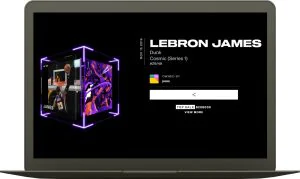Back in 2015, an iconic hip-hop band Wu-Tang Clan released a single-copy album called Once Upon A Time In Shaolin. The band intended to create a music album that is the one-of-a-kind piece of art. And they managed to do this well enough, as the album was sold at the auction Paddle8 for $2 million.
Once Upon A Time In Shaolin album was sealed into a luxurious box
Sounds crazy, but it’s true. A single-copy album produced by the most influential hip-hop stars obviously presents a significant artistic value, so purchasing it does make sense. But what about buying a non-fungible token (NFT) of a… em… a fart? Or a digital drawing of a rock for the price of a nice small house?
Which one do you like? How much are you willing to pay for it?
If all of this looks bizarre to you, that’s because it is. But people are serious about NFTs and are ready to splash out tons of money on them. Otherwise, nobody would buy a collaged digital image for $69 million. At the same time, the hype around NFTs looks like just another bubble, since significant dropdowns of the NFT market have happened already.
But is NFT overhyped? It’s definitely not, because NFT is a real technology which is likely to become web3’s flagship. In this article, the JatApp team together with the NFT artist Ivanna Ostapchuk will debunk the most common myths and prejudices about NFTs and their future.
One of Ivanna’s artworks listed at the OpenSea marketplace
NFTs change our attitude towards owning things
If you’re questioning the true value of NFTs, you probably know how they work. But still, let’s make sure that we are on the same page and give NFTs a brief definition. Non–fungible tokens, or NFTs, are any digital (and sometimes physical) assets that have a proof of originality by a blockchain-powered smart contract.
If you want to buy an NFT, you go to a marketplace or a website where NFT collections are sold. Then, you pay in cryptocurrency, and a non-fungible token is assigned to your wallet via a smart contract. Congratulations, you own an NFT!
But why can’t you just download a digital image by making a right click and pressing “Save as…”? Well, you can, this option does exist. But it won’t give you the right of owning the image.
Ivanna Ostapchuk made a sharp and straightforward comment on by far the most annoying question about NFT art: “People should better research the idea behind NFTs and then make a judgment. If somebody doesn’t understand the whole NFT story, it’s mostly likely because they did not try to learn more about it”.
That’s why we took a scientific yet understandable approach to explain what drives people to buy NFTs. Psychology Today explains the phenomenon of NFT with a humans’ desire to own things they know about or believe in. In fact, people have four major reasons why they are ready to pay for NFTs:
- Scarcity. In this case, we’re not that much different from animals. When you take a ball, your dog runs to you in an attempt to take the ball away from you. The dog thinks that the ball is something important, since you grabbed it fast enough to possess. The same thing works with NFTs that are intentionally scarce. For our brain, it doesn’t matter, as it sees that something is of a limited availability, so it pushes a human to get it. What if this digital drawing of a bored ape is important for survival? Got to buy it!
- Social proof. Even though humans are also animals, we’re very social creatures. If a commonly accepted leader does something, we follow them because their actions are likely to result in our survival and prosperity. When people see that Stephen Curry has purchased a Pudgy Penguin NFT, they want their own Pudgy Penguin NFT as well.
- Signaling. Of course, following the leader is a clear sign that humans are social beings. But we also crave leadership ourselves. And buying a digital artwork of a pixel punk for a lot of money is a good way to show off implying “Hey humans, I am rich and cool enough to pay for that weird picture which you can download for free because you aren’t that rich and cool, so respect me”. Making insanely stupid purchases in terms of money is how people underline their social status, which is why buying NFT is just another way to do that.
- Investment. We won’t drone on and on about neuroscience here but just mention that human behaviors are very much shaped with a fear of suffering (pain) and desire of delight. We do everything to avoid pain and achieve delight. When we see that something can earn us money, which is unarguably delightful to the majority of humans, we jump straight into the action to grab that reward. For that reason, people invest in NFTs today despite all the controversies that the media keep speculating about.
Blockchain technology seriously changes our perception of owning something. With smart contracts and tokenization of almost anything, people can leave a digital sign that a particular object (even a virtual one) belongs to them. As a result, the above-mentioned motivations are easy to fulfill.
Ivanna Ostapchuk comments on that: “This is natural. Technology moves forward everyday, so does art. And people want to own artworks for quite common reasons. It doesn’t matter where you have your artwork — hanging on a wall or stored in a blockchain”.
On a side note, we would like to say a couple of words about owning an NFT artwork and copyright. These concepts are not the same, just keep it in mind.
You can dive deep into a discussion of the NFT copyright puzzle, while we have a much simpler explanation made by Ivanna: ”Any artist, especially one working with NFT, wants to keep their intellectual property rights. If a consumer buys an NFT, they can do with it whatever they want, except for making money. That’s the right any artist would like to preserve”.
If NFTs were a bubble, it would explode. But it won’t.
Ivanna Ostapchuk and the JatApp team are happy that we’ve managed to convince you that NFTs aren’t that alien and idiotic. But you may have doubts about the future of NFT: it does look like a bubble which is going to explode, while a scandalous cryptomarket downfall is evolving in the background.
NFTs, as well as the entire web3 industry, are facing unpleasant headwinds that have already blown off many promising startups and NFT marketplaces. Even though the situation can turn tectonic quite often, the NFT industry always pivots to a certain end: to grow by 34% in 2030 and stay with users forever.
NFTs aren’t about money in the first place. That is why all the hell breaking loose within the cryptocurrency market won’t affect NFTs. Cryptocurrency is money, and NFTs are the art that does not work according to the money rules. Excuse us for an excessively eloquent speech here, but NFTs don’t have anything to lose, while the cryptomarket does. Ironically, it’s much safer to invest in an NFT of a recorded fart than in a crypto exchange marketplace that fails because its rival tweeted about its financial instability.
Putting all jokes aside, let’s discuss a case of an NFT project called NBA Top Shot Moments developed by Dapper Labs, which is a good example of how NFTs follow a typical financial bubble scenario, but don’t leave consumers frustrated in the end.
The NBA Top Shot NFT with LeBron James making a spectacular slam dunk was sold at $208,000 back in February 2021. Today, the average price of an NBA Top Shot Moment is around $17.
The NFT collection of best pro-basketball moments was so popular that the marketplace was unable to process that many visitors and didn’t work for hours. To compensate for the downtime, the company kept releasing more and more Moments. Looks like a perfect recipe for disaster, doesn’t it?
The prices indeed fell that low, but it’s not a catastrophe for Dapper Labs as they keep expanding the collection today. The matter is that Top Shots NFTs aren’t about making a smart investment. They are about the experience of collecting things you’re fond of. Ivanna Ostapchuk adds: “Many people collect art or any other things because they love collecting something. NFTs can be just like Kinder Surprise toys, but you don’t risk getting the same one twice”.
On top of that, a search for a logic behind price change of something as subjective as digital art is just barking up the wrong tree. Art grows in value because of multiple, often random, factors. Such crazy price swings are a natural state of the NFT market. So if you’re going to invest in NFT, you should accept that fact.
Also, you should be more picky about the artistic merit of an NFT you want to purchase. Ivanna Ostapchuck says that “The NFT market is mostly open, and everybody can enter it. No doubt, it’s cool that everybody can share their art and get paid for that, but a growing number of amateurs naturally increases the volume of plagiarized, sometimes stolen, or simply shallow artworks with just an idea to make money out of nothing”. Don’t bother yourself with price changes, but think about what experiences you get with an NFT you’re going to buy.
By mentioning experiences, we don’t imply just an experience of encountering the work of art. Advantages of NFTs have a thousand faces: blockchain-based gaming, metaverses, and fictional interactive stories. Some musicians sell their albums and fanclubs offer sports events tickets in a form of non-fungible tokens.
Kings of Leon album presold as NFT
The more the economy moves onto the Internet, the more likely NFTs will get practical use in the future. In fact, NFTs already have a lot to tell about their use cases. We’re working on the relatable article, so stay tuned!
The whole world is NFT
Even though web3 doesn’t promise to mature into a new era of the Internet, the NFTs market is certainly not a bubble stuffed with hype. Once NFTs have survived several serious price roller-coasters and got many use cases beyond just being expensive digital pictures, we can conclude that NFTs are here to stay. You can develop your own NFT business towards any direction you find exciting and profitable. Ivanna Ostapchuk, our host NFT artist, sums up: “NFTs can be an art, a business, a collectible, a game, anything you want it to be. That’s the main reason why NFTs are immensely popular: they get a meaning you give them. When many people believe in the same things, these things become valuable”.
If you have an idea of an NFT-powered startup, you can ask JatApp for help both with tech and business domains. Our company has delivered more than 200 successful digital projects, including development of a blockchain-based content management platform for the United Arab Emirates government.
JatApp is always happy to accept challenging tasks and empower businesses to harness creative digital solutions. Just leave us a note to initiate collaboration with us. We’ll get back to you soon to discuss the details of your project.












